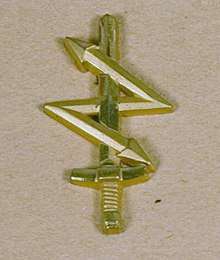Swedish Army Signal Troops

Swedish Army Signal Troops (Swedish: Signaltrupperna) is the signal branch of the Swedish Army.
History
The Swedish Army Signal Troops were organized in accordance with the Defence Act of 1936 as a special branch of the field telegraph troops which belonged to the Fortifikationen. The signal troops consisted of the Signal Regiment (S 1) with the main part in Stockholm Garrison and a company in each of Kristianstad Garrison (S 1 K), Skövde Garrison (S 1 Sk) and Boden Garrison (S 1 B). From the signal troops, a large number of officers were also commanded for service in senior staffs.[1][2]
Units, except regiments, battalions, corps and companies of the Swedish Army Signal Troops, included the Swedish Army Signal School (Arméns signalskola, SignS) (1942–1965) which became the Swedish Army School of Staff Work and Communications (Arméns stabs- och sambandsskola, StabSbS) (1965–1998) which in turn was part of the Swedish Army Staff and Communication Center (Arméns lednings- och sambandscentrum, LSC) (1991–1997) along with the Army Staff's Signal Department (Arméstabens signalavdelning) and (Signaltruppernas officershögskola, SignOHS). The Swedish Army Signal Cadet and Officer Candidate School (Signaltruppernas kadett- och aspirantskola, SignKAS) was active from 1961 to 1981 when it became a part of the Swedish Army School of Staff Work and Communications.
Today's signal troops mainly include staff and military communications units, and electronic warfare units. The Command and Control Regiment in Enköping has since 2007 taken over the previous tasks of the signal troops.
Inspector of the Swedish Army Signal Troops
In the years 1966-1991, the signal and engineer troops had a joint branch inspector; the Inspector of the Swedish Army Engineer Corps and Signal Corps (Ingenjörinspektör- och Signalinspektören).[note 1] From 1991, the two branches received an inspector each, and the title of the signal troops was shortened to the Signal Inspector.[4] In connection with the decommissioning of Swedish Army Staff and Communication Center (Arméns lednings- och sambandscentrum), the position of Signal Inspector disappeared.
- 1942–1948 – Gottfried Hain
- 1948–1954 – Åke Sundberg
- 1954–1955 – Hilding Kring
- 1955–1959 – Fale Burman
- 1959–1962 – Gunnar af Klintberg
- 1962–1966 – Bengt Uller
- 1966–1967 – Gunnar Smedmark
- 1967–1967 – Harald Smith (acting)
- 1968–1969 – Harald Smith
- 1969–1975 – Åke Bernström
- 1975–1982 – Kåre Svanfeldt
- 1982–1986 – Owe Dahl
- 1986–1991 – Bertil Lövdahl
- 1992–1998 – Lars Dicander
See also
Footnotes
References
- ↑ Carlquist, Gunnar; Carlsson, Josef, eds. (1955). Svensk uppslagsbok (in Swedish) (2nd, rev. and expand. ed.). Malmö : Förlagshuset Norden. pp. 1083–1084. LIBRIS 11112.
- ↑ Gunnarsson, Gunnar, ed. (1948). Norstedts uppslagsbok: illustrerad encyklopedi i ett band (PDF) (in Swedish) (4th, rev. ed.). Stockholm: Norstedt. p. 1589. LIBRIS 12469179.
- ↑ Gullberg, Ingvar E. (1977). Svensk-engelsk fackordbok för näringsliv, förvaltning, undervisning och forskning [A Swedish-English dictionary of technical terms used in business, industry, administration, education and research] (in Swedish) (2nd ed.). Stockholm: Norstedt. p. 1411. ISBN 91-1-775052-0. LIBRIS 8345587.
- ↑ Johansson, Lennart; Dicander, Lars; Westergren, Per-Olof (2017-01-21). "Bertil Lövdahl". Dagens Nyheter (in Swedish). Retrieved 16 March 2018.